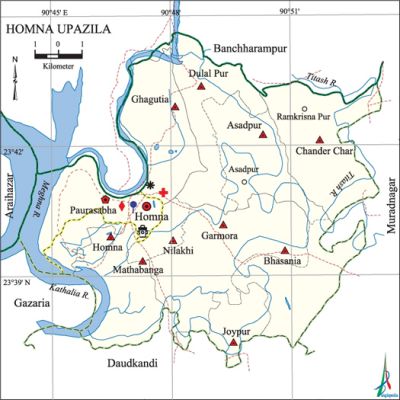Homna Upazila
Homna Upazila (comilla district) area 142.78 sq km, located in between 23°37' and 23°45' north latitudes and in between 90°38' and 90°53' east longitudes. It is bounded by banchharampur upazila on the north, daudkandi and gazaria upazilas on the south, muradnagar upazila on the east, araihazar upazila on the west.
Population Total 206386; male 100245, female 106141; Muslim 194296, Hindu 12085, Buddhist 4, and others 1.
Water bodies Main rivers: meghna, titas,' Kathalia; Luitar Beel, Darirchar Beel, Kasimpur Beel, Kalidhoar Beel and Khodadawdpur Beel are notable.'
Administration Homna Thana, now an upazila, was formed in 1918.
| Upazila | ||||||||
| Municipality | Union | Mouza | Village | Population | Density (per sq km) | Literacy rate (%) | ||
| Urban | Rural | Urban | Rural | |||||
| 1 | 9 | 73 | 154 | 29173 | 177213 | 1445 | 46.4 | 38.6 |
| Municipality | ||||||||
| Area (sq km) |
Ward | Mahalla | Population | Density (per sq km) |
Literacy rate (%) | |||
| 11.73 | 9 | 13 | 29173 | 2487 | 46.4 | |||
| Union | ||||
| Name of union and GO code | Area (acre) | Population | Literacy rate (%) | |
| Male | Female | |||
| Asadpur 15 | 3969 | 9459 | 11283 | 38.1 |
| Garmora 50 | 2210 | 7988 | 7829 | 35.2 |
| Ghagutia 47 | 3507 | 8339 | 9589 | 30.8 |
| Chander Char 28 | 3289 | 11663 | 13199 | 42.5 |
| Joypur 25 | 1583 | 6344 | 6224 | 42.9 |
| DulalPur 22 | 7188 | 10709 | 11694 | 34.8 |
| Nilakhi 85 | 4773 | 11193 | 9982 | 44.0 |
| Bhasania 20 | 3191 | 10935 | 10901 | 40.8 |
| Mathabhanga 76 | 4050 | 9313 | 10569 | 37.0 |
Source Bangladesh Population Census 2011, Bangladesh Bureau of Statistics.

Archaeological heritage and relics Homna Kali Mandir, Karakandi Balagazi Mosque.
War of Liberation At the end of July 1971 the Pak army tried to enter the Joypur village through the Titas river. The freedom fighters attacked them from both the banks of the river, which caused serious damage to the motor launch carrying the enemies. The Pak army retreated towards Machhimpur. A number of Pak soldiers were killed or wounded in this encounter. Besides, encounters were held between the freedom fighters and the Pak army at different other places of the upazila including Champak Nagar, Ghagutia, Nilokhi Bazar, Dulal Bazar, Homna Sadar and Panchabati, in whcih 23 freedom fighters were killed and 24 were wounded. The Pak army buried alive a number of men, women and children at a place adjacent to the Homna Degree College. There is one mass grave in the upazila and a memorial monument has been built.
For details: see হোমনা উপজেলা, বাংলাদেশ মুক্তিযুদ্ধ জ্ঞানকোষ (Encyclopedia of Bangladesh War of Liberation), বাংলাদেশ এশিয়াটিক সোসাইটি, ঢাকা ২০২০, খণ্ড ৮।
Religious institutions Mosque 350, temple 26, sacred place 2. Noted religious institutions: Karakandi Balagazi Mosque, Homna Kali Mandir.
Literacy rate and educational institutions Average literacy 39.7%; male 41.9%, female 37.6%. Educational institutions: college 4, vocational training instituate 1, secondary school 16, primary school 108, kindergarten 2, madrasa 278. Noted educational institutions: Mathabhanga Bhairab High School (1919), Ramkrishnapur KRK High School (1928), Homna Government Pilot High School (1929). Ghaniarchar Uttar Government Primary School (1905), Joypur Government Primary School (1918), Barakalmina Government Primary School (1919)
Newspapers and periodicals Weekly: Homna; Daily: Homna.
Cultural organisations Library 1, shilpakala academy 1, playground 10.
Main sources of income Agriculture 46.91%, non-agricultural labourer 2.45%, industry 5.54%, commerce 17.16%, transport and communication 1.73%, service 6.18%, construction 1.24%, religious service 0.28%, rent and remittance 3.26% and others 15.25%.
Ownership of agricultural land Landowner 66.08%, landless 33.92%; agricultural landowner: urban 66.44% and rural 66.02%.'
Main crops Paddy, wheat, corn, potato, sesame, mustard, musuri, vegetables.
Extinct or nearly extinct crops Kaun, china, mugh.
Main fruits Mango, water-melon, futi, papaya.
Fisheries, dairies and poultries Fishery 1, poultry 40.
Communication facilities Pucca road 107 km, mud road 155 km; waterway 38 km.
Extinct or nearly extinct traditional transport Palanquin.
Noted manufactories Rice mill, saw mill, flour mill, oil mill, ice factory, welding factory, candle and chanachur making factory.
Cottage industries Goldsmith, potteries, weaving, embroidery, bamboo work, wood work.
Hats, bazars and fairs Hats and bazars are 27, fairs 2, Homna Hat, Ramkrishnapur Hat, Dulalpur Hat, Mirash Hat, Kashipur Hat, Shreepur Hat, Joypur Hat, Asadpur Hat, Paus Mela and Baishakhi Mela.
Main exports Wheat, potato, sesame, mustard, musuri, vegetables.
Access to electricity All the wards and unions of the upazila are under rural electrification net-work. However 86.0% of the dwelling households have access to electricity.
Sources of drinking water Tube-well 92.2%, tap 1.4% and others 6.4%. The presence of arsenic has been detected in shallow tube-well water of the upazila.
Sanitation 76.9% of dwelling households of the upazila use sanitary latrines and 18.4% of dwelling households use non-sanitary latrines; 4.7% of households do not have latrine facilities.
Health centres Upazila health centre 1, union health and family planning centre 7, satellite clinic 5, veterinary hospital 1, rural health centre 7, clinic 10.
Natural disasters The tornado of 1969 and the flood of 1998 caused heavy damages to settlements and crops of the upazila.
NGO activities Operationally important NGOs are brac, asa. [Md Mazharul Islam]
References Bangladesh Population Census 2001 and 2011, Bangladesh Bureau of Statistics; Cultural survey report of Homna Upazila 2007.
